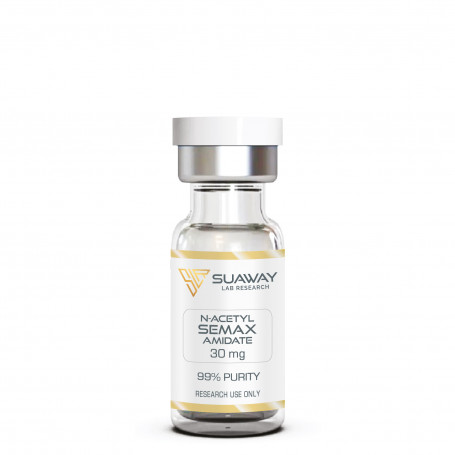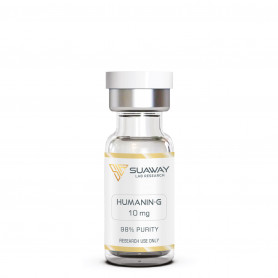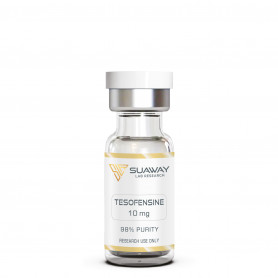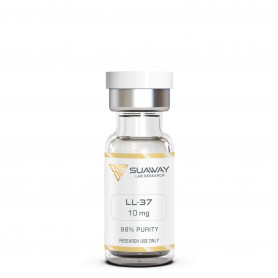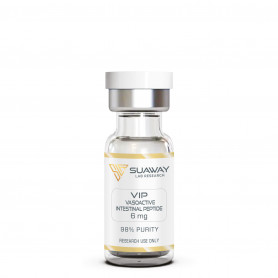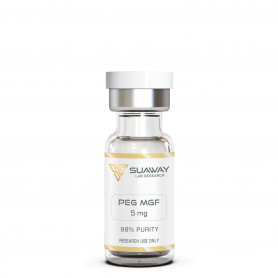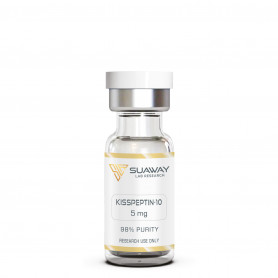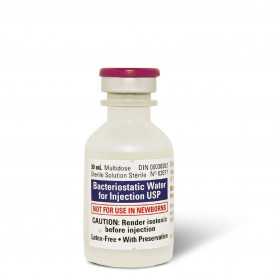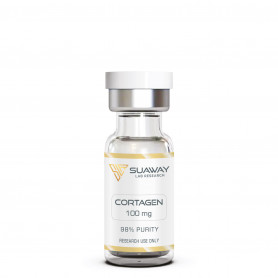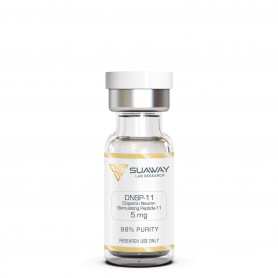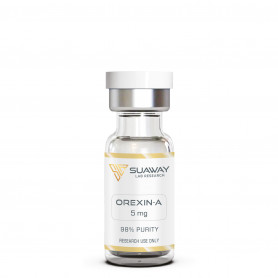N-ACETYL SEMAX AMIDATE - 30 mg
A synthetic peptide known as N-Acetyl Semax Amidate is prized for its neurogenic & neurorestorative effects. It is beneficial against illnesses of the optic nerve, stroke, or ischemic heart disease, according to research, and it enhances memory and cognitive performance. It could also improve immune function.
- The search suggests that N-Acetyl Semax Amidate has the following effects:
- Neuroprotective effects
- Prevents nerve damage
- Improves cognitive properties
- Protects cardiovascular system
- Reduces the symptoms of ADHD
- Increases attention
- Decreases stress and pain levels
Description
STRUCTURE
Sequence: Ac-Met-Glu-His-Phe-Pro-Gly-Pro-NH2
Molecular Formula: C39H54N10O10S
Molecular Weight: 854,38 g/mol
CAS Number: 80714-61-0
Peptide Purity: Greater than 99%
Other details: No TFA Salt, No Mannitol
Storage: Lyophilized peptide must be stored at -20°C and peptide solution at 4°C.
N-Acetyl Semax Amidate is more effective than other standard Semax formulations, according to extensive studies.
DESCRITPION
Adrenocorticotropic hormone fragment 4-10 is a natural human hormone fragment that is analogous to the synthetic polypeptide N-Acetyl Semax Amidate (ACTH 4-10). A peptide fragment from the adrenocorticotropic hormone released by the anterior pituitary gland is known as ACTH fragment 4–10. Interestingly, this fragment does not show any effects that are typical of ACTH, but it does have a distinct impact on the human brain, improving memory and attention.
According to a research study, N-Acetyl Semax Amidate, like psychostimulants, elevates dopamine production and release while also raising brain levels of brain-derived neurotrophic factor (BDNF). As a result, it increased attention levels and enhanced brain growth.
The nootropic impact of ACTH hormone and its analogs, particularly N-Acetyl Semax Amidate, was investigated in rats. The levels of 5-hydroxyindoleacetic acid (5-HIAA) were checked after the peptide delivery. After two hours of N-Acetyl Semax Amidate treatment, 5-HIAA levels increased by 25%. In contrast, the levels rose progressively over the next four hours, reaching a high of 180%.
Because of this, N-Acetyl Semax Amidate can increase the release of dopamine neurotransmitters in the striatum, which enhances cognitive abilities.
In Russia, a small-scale clinical experiment was carried out to examine the effects of Semax on the human brain when it was provided to healthy male volunteers under stressful circumstances. Volunteers received an intranasal dosage of Semax ranging from 0.015 to 0.050 mg/kg body weight. After around 24 hours of the trial, it was reported that the participants had improved their memory and attention compared to before, with no evidence of any other unfavorable side effects. This suggested that the peptide could be a safe medicinal substance for the treatment of neurological diseases.
In Russia, N-acetyl Semax amidate is used to treat acute cerebral hypoxia, which might result from a stroke or severe brain damage. N-acetyl Semax amidate promotes a variety of molecular pathways involved in gene transcription in the central nervous system, according to research done on rats (CNS). In the brain and spinal cord, N-Acetyl Semax Amidate specifically induces alterations in the expression of 24 distinct genes involved in blood vessel function. These genes control the creation of red blood cells, the migration of smooth muscle cells, and the development of new blood vessels. The neuroprotective effects of N-acetyl Semax amidate in the context of a stroke may be explained by this association. It seems that the peptide enhances the availability of nourishment to the brain, encourages the survival of neurons, stabilizes mitochondria, and hence energy generation. N-acetyl Semax amidate seems to hasten the recovery of brain function, according to research done in Russia on stroke patients undergoing rehabilitation.
According to certain research, early rehabilitation and the use of N-Acetyl Semax Amidate boost BDNF levels in the blood, hasten functional recovery, and enhance motor function.
One such clinical experiment included 100 people who had an ischemic stroke. Individuals who had mild or moderately severe strokes received a dosage of 12 mg of Semax, while patients who had severe strokes received a dose of 18 mg. The trial lasted between five and ten days. Following administration, it was seen that there was some improvement in the repair rate of impaired neurological functions when Semax was co-administered with the usual treatment. EEG mapping was used to examine all of the findings. In combination with existing treatments, this research showed that Semax may be used to treat neurological conditions and nerve damage.
The effects of N-acetyl semax amidate on gene expression in the brain are not limited to stroke-related alterations. N-Acetyl Semax Amidate has been shown to affect a variety of distinct genes in the hippocampus and frontal cortex after a single intranasal treatment in healthy rats. This is relevant because the frontal cortex is crucial for focus, planning, and information organization, but the hippocampus is essential for memory and learning. Within 20 minutes of N-Acetyl Semax Amidate injection, gene expression in both tissues is seen. Nerve growth factor (NGF) and BDNF are especially strongly affected.
Furthermore, studies on mice have shown that raising BDNF levels might aid in controlling brain activity in depressive states. Modern antidepressants, such as SSRIs, often work by indirectly influencing serotonin transmission in the brain, but it frequently takes several weeks of medication to observe any results. Now, it seems that SSRIs may take a long time to operate since their true therapeutic impact is tied to their capacity to raise BDNF levels and hence drive neurogenesis in the depressed brain. This is owing to knowledge gathered from N-acetyl Semax and other BDNF-boosting proteins. Research suggests that combining BDNF stimulators, such as N-acetyl Semax amidate, with SSRI therapy might significantly increase effectiveness and facilitate the treatment of depression.
N-Acetyl Semax Amidate has effects on the cardiovascular system as well. Numerous research has examined Semax's ability to prevent rat cardiac vascular damage after myocardial infarction (MI). Semax was given intraperitoneally to rats suffering from myocardial infarction over the next 6 days at a dosage of 150 microg/kg body weight.
The untreated rats developed cardiac hypertrophy and reduced arterial blood pressure on the 28th day after the myocardial infarction. These symptoms pointed to cardiac failure. While rats treated with Semax exhibited signals that the diastolic pressure increase in the left ventricle was prevented, exhibiting positive effects on the remodeling of the left ventricle and preventing heart failure.
In synthetic chemistry, N-acetylation is used to alter the charge, hydrophobicity, and size of a protein. This can impact how long the protein lasts, where it localizes to in the body, and what receptors it binds to. In most cases, N-acetylation is done to prolong the half-life of a protein without affecting its overall function. It is a relatively simple process, making it an affordable and well-known mechanism for improving the potency of a peptide.
Amidation is another minor peptide modification, this time to the carboxyl group on the other end of the amino acid chain. Like N-acetylation, amidation is a natural process that occurs in up to half of all known peptides. Amidation makes peptides less sensitive to proteolytic degradation and extends their half-life in the blood stream. Amidated peptides are less sensitive to changes in pH and more easily bind to their receptors. They also bind more tightly to their target receptors, a feature that extends the effects of amidated proteins as compared to their non-amidated counterparts.
In synthetic biology, amidation serves to several functions. First, amidation helps to protect orally administered peptides from the harsh environment in the stomach and GI tract. The second reason that most synthetic peptides are amidated is to improve their potency after absorption. Amidated proteins not only survive longer in the bloodstream, they bind more tightly to their target receptors and produce enhanced signaling as a result. This latter fact is particularly important for peptides that are active in the central nervous system, like Semax. Finally, amidation increases lipid solubility and thus increases the amount of Semax crossing the BBB. So, not only is N-Acetyl Semax Amidate more potent due to enhanced receptor binding, but more of it also reaches the receptors in the central nervous system.
REFERENCES
T.L.Agapova et al., "Effect of semax on the temporary dynamics of brain-derived neurotrophic factor and nerve growth factor gene expression in the rat hippocampus and frontal cortex" [PubMed]
I.S. Lebedeva et al., "Effects of Semax on the Default Mode Network of the Brain" [PubMed]
K.O. Eremin et al., "Semax, an ACTH(4-10) analogue with nootropic properties, activates dopaminergic and serotoninergic brain systems in rodents" [PubMed]
E.I. Gusev et al., "The efficacy of semax in the tretament of patients at different stages of ischemic stroke" [PubMed]
Shih-Jen Tsai "Semax, an analogue of adrenocorticotropin (4-10), is a potential agent for the treatment of attention-deficit hyperactivity disorder and Rett syndrome" [PubMed]
E.I. Gusev et al., "Effectiveness of semax in acute period of hemispheric ischemic stroke (a clinical and electrophysiological study)" [PubMed]
S.I. Gusev et al., "Semax in prevention of disease progress and development of exacerbations in patients with cerebrovascular insufficiency" [PubMed]
O.V. Dolotov et al., "Semax, an analogue of adrenocorticotropin (4-10), binds specifically and increases levels of brain-derived neurotrophic factor protein in rat basal forebrain" [PubMed]
V. Stavchansky et al., "The effect of Semax and its C-end peptide PGP on the morphology and proliferative activity of rat brain cells during experimental ischemia: a pilot study" [PubMed]
L.V. Dergunova et al., "The Peptide Drug ACTH(4-7)PGP (Semax) Suppresses mRNA Transcripts Encoding Proinflammatory Mediators Induced by Reversible Ischemia of the Rat Brain" [PubMed]
A. Magrì et al., "Influence of the N-terminus acetylation of Semax, a synthetic analog of ACTH(4-10), on copper(II) and zinc(II) coordination and biological properties" [PubMed]
M. Shypshyna et al., "Effect of peptide semax on synaptic activity and short-term plasticity of glutamatergic synapses of co-cultured dorsal root ganglion and dorsal horn neurons" [PubMed]
E.V. Iakovleva et al., "Study of the efficacy of semax in global cerebral ischemia in vivo" [PubMed]
DISCLAIMER
This product is intendend for lab research and development use only. These studies are performed outside of the body. This product is not medicines or drugs and has not been approved by the FDA or EMA to prevent, treat or cure any medical condition, ailment or disease. Bodily introduction of any kind into humans or animals is strictly forbidden by law. This product should only be handled by licensed, qualified professionals.
All product information provided on this website is for informational and educational purposes only.


